Down with Animate Elitism! by Burn Unit
December 18th, 2007 12:07 PM Iconography that resembled any kind of ancient forms and rigid traditions was the furthest thing from my mind six weeks ago. In the course of painting, or "writing" an icon of the parable of the prodigal son, I formed a profound and unexpected intimate relationship with an inanimate object. I assumed we'd be learning about the process of iconography from a theological and historical perspective, and then be required to complete a project that resulted in an icon-like object, maybe write a paper. I was prepared to output something with my well-practiced skills in the trinity of technique, appearance, and product. How naive! It's also naive to forget that, even in my cynical moments, behind that trinity stands the original, most holy. In any case, time and mystery and spirit won out, using technique, appearance, and product in the service of higher and sometimes confounding purposes which I grasp now dimly.
Iconography that resembled any kind of ancient forms and rigid traditions was the furthest thing from my mind six weeks ago. In the course of painting, or "writing" an icon of the parable of the prodigal son, I formed a profound and unexpected intimate relationship with an inanimate object. I assumed we'd be learning about the process of iconography from a theological and historical perspective, and then be required to complete a project that resulted in an icon-like object, maybe write a paper. I was prepared to output something with my well-practiced skills in the trinity of technique, appearance, and product. How naive! It's also naive to forget that, even in my cynical moments, behind that trinity stands the original, most holy. In any case, time and mystery and spirit won out, using technique, appearance, and product in the service of higher and sometimes confounding purposes which I grasp now dimly.  We began by following the prototype laid down by, as far as I know, an unknown French painter several hundred years ago. We did some trace work using paper and carbon (something we'd get in trouble for if this was super strict?). The surface is a gesso-treated icon board, calcium and acrylic polymer built up on a wooden board and sanded smooth, provided by an outside supplier. Traditional icons are painted in egg tempera on a calcium-and-rabbit-skin-glue gesso. In this case, our teacher said it was appropriate to use acrylic. The acrylic is slightly easier to work with, and the point was made that "painting media are a technology; perhaps one shouldn't give special mystical significance to one media over another" and "if Rublev were alive today, would he be working in acrylics? possibly; we know we can't say for sure he wouldn't." This reasoning sufficed for the novice. I am not good at making the "yogurt like consistency" and fluidity of the media. This only occasionally bothers me. As I write more icons, I'm sure I'll get better at it.
We began by following the prototype laid down by, as far as I know, an unknown French painter several hundred years ago. We did some trace work using paper and carbon (something we'd get in trouble for if this was super strict?). The surface is a gesso-treated icon board, calcium and acrylic polymer built up on a wooden board and sanded smooth, provided by an outside supplier. Traditional icons are painted in egg tempera on a calcium-and-rabbit-skin-glue gesso. In this case, our teacher said it was appropriate to use acrylic. The acrylic is slightly easier to work with, and the point was made that "painting media are a technology; perhaps one shouldn't give special mystical significance to one media over another" and "if Rublev were alive today, would he be working in acrylics? possibly; we know we can't say for sure he wouldn't." This reasoning sufficed for the novice. I am not good at making the "yogurt like consistency" and fluidity of the media. This only occasionally bothers me. As I write more icons, I'm sure I'll get better at it. The process of writing an icon is supposed to usher the iconographer into the presence of the spirit of God. The instructor of our class writes
The icon reveals the image of the invisible God which is Jesus Christ made incarnate. “Christ,”says St. Paul, “is the icon of the invisible God” (Colossians 1:15*) (...)The church becomes the meeting place between God and humanity and where we experience God’s presence. We then take and live the Church everywhere we go in God’s creation; the Living Church. The icon functions and becomes a visible sign revealing the relationship between God and humankind.*The relevant verse in Colossians reads οστις ειναι εικων του Θεου του αορατου, πρωτοτοκος πασης κτισεως
Lutherans don't believe all this stuff, generally speaking. However, I find little discord here. To me there's a fairly consistent line between Christ the "eikon" of God and the belief that an action of painting surrounded in prayer would reflect this movement of God, through incarnation, into the prayerful artist, and subsequently outward to the kosmos. This process is not sacramental to me, in the strict sense. However it is illuminating and meditative, a definite spiritual process of faith in the presence of the spirit, and acting on that to materialize the painting.
 Ever present in this are reflections on the parable of the prodigal son. Which is really where the intimacy takes root for me. During the course of writing the icon we occasioned to discuss the parable. It interests me from a process perspective, because most icons are images of saints or once-living persons. Icons of the parables are subtly different. The parables are not literal--certainly they shouldn't be read that way. There wasn't ever a man "going down who was set upon by thieves and helped by a good Samaritan." There was no son who took his inheritance early (which is to say, he said "you're dead to me" to his dad, think about it) and spent it lavishly and had a change of life and was welcomed back with feasting. There wasn't! These are stories from Jesus' lips, see? The figures in parables aren't real. Except. Well, see, they're spoken into the world through the incarnate logos. That is to say, they are transformative words from the living Word. So they have a life of their own that is real. (Tolkienists, this is a kind of echo of what the man referred to in saying myths can be more real than history, or it prefigures it. He certainly was aware of the parables of Jesus when he went about talking about and making myths.) Inasmuch as they do, depicting them iconographically is an effort to illuminate the eternal light that animates and exteriorizes their lives.
Ever present in this are reflections on the parable of the prodigal son. Which is really where the intimacy takes root for me. During the course of writing the icon we occasioned to discuss the parable. It interests me from a process perspective, because most icons are images of saints or once-living persons. Icons of the parables are subtly different. The parables are not literal--certainly they shouldn't be read that way. There wasn't ever a man "going down who was set upon by thieves and helped by a good Samaritan." There was no son who took his inheritance early (which is to say, he said "you're dead to me" to his dad, think about it) and spent it lavishly and had a change of life and was welcomed back with feasting. There wasn't! These are stories from Jesus' lips, see? The figures in parables aren't real. Except. Well, see, they're spoken into the world through the incarnate logos. That is to say, they are transformative words from the living Word. So they have a life of their own that is real. (Tolkienists, this is a kind of echo of what the man referred to in saying myths can be more real than history, or it prefigures it. He certainly was aware of the parables of Jesus when he went about talking about and making myths.) Inasmuch as they do, depicting them iconographically is an effort to illuminate the eternal light that animates and exteriorizes their lives.  I have always found the story of the prodigal son to be very moving. The text of it is wonderful and I especially feel the little details are beautiful. In the moment of the embrace, some translations render the action of the father racing out to greet his son and "falling upon his neck"--just imagine a furious, inexpressibly joyful and exhausting embrace between parent and child. "My son who was lost! who was dead! is found!" This excitement is the excitement of the kingdom of heaven over the embrace with any lone lost littlest and least person. I enjoy the phrasing of the moment the son, actually reduced to wallowing among pigs, "comes to himself." It's a profound turn, the presumed sinner not making a big decision for Jaysus, (puraise tha lawd, yes!) has an existential moment of coming to himself, naked and urgent. I've also taken comfort in the reading that, sometimes we are not the father or the son or even the jealous brother, but rather we are the nearby servants, incidental to the story, called to be ready and help facilitate the feasting at the end. Not a bad metaphor for the church, in my opinion (and a kind of linchpin in my own theological agenda). The power of this icon also lies in how it depicts this decisive moment, the reunion of the father and son, the embrace, on an empty and receding ground. No other embellishments, no other persons present, just the moment of connection, the hands upon the body, the fingers beginning to tangle in the robes. There's bursts of light for me, at the hands and faces, the moments of recognition and familiar intimacy. The father's face is a picture of compassion (despite my shortcomings of matching the placement of his eyes to their positions on the prototype, I should point out). I had an audible gasp when the gold leaf was applied to the halo; on each of the icons in our group. Ah. There! The burst of the divine is here, the center of the living heart of god is the expression of love for the lost, the expression of touch, the heartbreak of reunion. such. this. this is where we belong. Ah. Ah!
I have always found the story of the prodigal son to be very moving. The text of it is wonderful and I especially feel the little details are beautiful. In the moment of the embrace, some translations render the action of the father racing out to greet his son and "falling upon his neck"--just imagine a furious, inexpressibly joyful and exhausting embrace between parent and child. "My son who was lost! who was dead! is found!" This excitement is the excitement of the kingdom of heaven over the embrace with any lone lost littlest and least person. I enjoy the phrasing of the moment the son, actually reduced to wallowing among pigs, "comes to himself." It's a profound turn, the presumed sinner not making a big decision for Jaysus, (puraise tha lawd, yes!) has an existential moment of coming to himself, naked and urgent. I've also taken comfort in the reading that, sometimes we are not the father or the son or even the jealous brother, but rather we are the nearby servants, incidental to the story, called to be ready and help facilitate the feasting at the end. Not a bad metaphor for the church, in my opinion (and a kind of linchpin in my own theological agenda). The power of this icon also lies in how it depicts this decisive moment, the reunion of the father and son, the embrace, on an empty and receding ground. No other embellishments, no other persons present, just the moment of connection, the hands upon the body, the fingers beginning to tangle in the robes. There's bursts of light for me, at the hands and faces, the moments of recognition and familiar intimacy. The father's face is a picture of compassion (despite my shortcomings of matching the placement of his eyes to their positions on the prototype, I should point out). I had an audible gasp when the gold leaf was applied to the halo; on each of the icons in our group. Ah. There! The burst of the divine is here, the center of the living heart of god is the expression of love for the lost, the expression of touch, the heartbreak of reunion. such. this. this is where we belong. Ah. Ah!Throughout this entire experience, my wife's brother has been in jail. I'm not going to go into details, but he awaits trial for some terrible accusations. The worry, the sense of loss of her brother weighs heavily on her whole family. Over the course of about twenty five total hours painting, I have prayed and prayed for a "moment" like this, for something some burst of light about our bony structures, to illumine these dark times. I found myself hovering the brush over the board, some color on it, murmuring "come holy spirit" just aching for a presence to guide the hand, straighten this line, make that one suitably ragged, reveal the truth in this mix of color. It's been an Advent season of the most abject desperate longing for signs and above all for presence, for Emmanuel, God with us.
At the end, we held a brief private service in which the other instructor (retired seminary pastor) read a blessing over the icons. We don't venerate icons the same way in our tradition, or really any object--no "adoration of the host" for example, for those of you from a Catholic background. But we do often ask for blessings over things, and people, and times, and places; prayers of presence and faith that when we are gathered in the name, we are in the presence of God. This object I've made isn't holy, per se. I don't hold the craft of it to be particularly skilled--I'm no painter and it's a novice iconographer's work. But it is an object of journey, and of meditation and attentiveness and spiritual intimacy, made material. While not holy, it is bless-ed, and I keep faith that blessings will come of it. It will of course be given as a Christmas gift to my mother- and father-in-law.
early stages
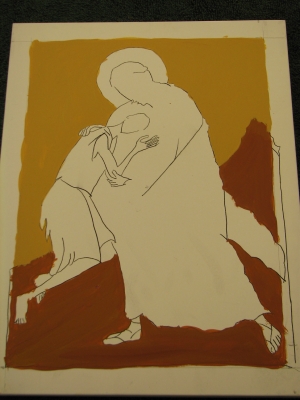
don't have the phone pix I took of the first day, but I brought the good camera to the rest of the sessions.
ground
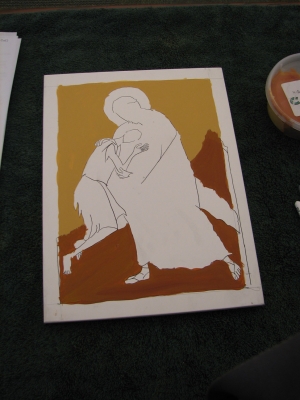
I think that ground is mostly yellow oxide and red oxide. the sky is yellow oxide with titanium white and perhaps a hint of red to take the edge off.
starting robe
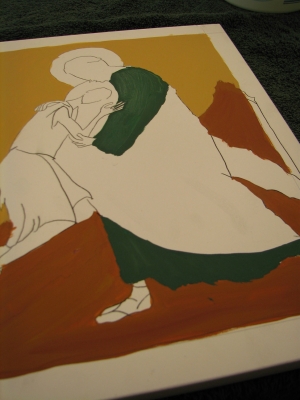
I believe if we'd done this with more time and a very strict interpretation, the whole background would be washed and we'd build up all the colors from that green, or possibly blue.
red and green
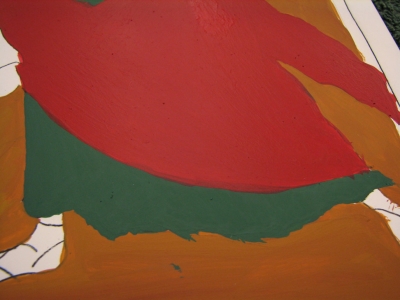
there's a lot of intersections. I spent quite a bit of time meditating on the boundaries between colors. where does one robe begin and end? how much does it take to opaque over the color below? where do I begin and end?
flesh and build up
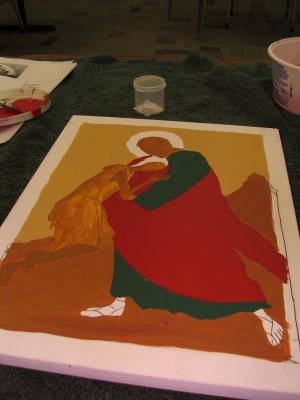
the skin is in raw sienna. we were told that traditionally white is built up from other colors but we could put the son's robe in white, just pure white. it happened I had about three extra hours of time on my hands so instead I started him in raw sienna, and added white and white and more white until the top layer of the robe was white. Often they build up from dark blue, though she said a person could build up from any color. I wanted to dress the flesh so to speak, so I started with the raw sienna.
prayer.WAV
Prayer spoken before painting. This was the last of the pre-class prayers. We prayed together regularly before beginning. You can probably hear my voice the loudest on this recording.
natural light
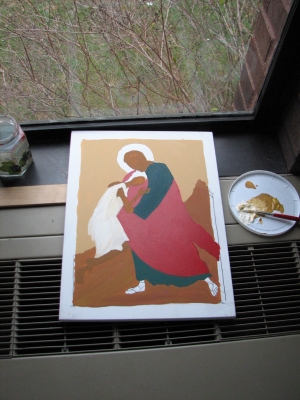
on robe buildup day I was all alone working in the room, and I got kind of nuts about the natural light. so I hunched next to the only window that had a surface in front of it and worked there.
border
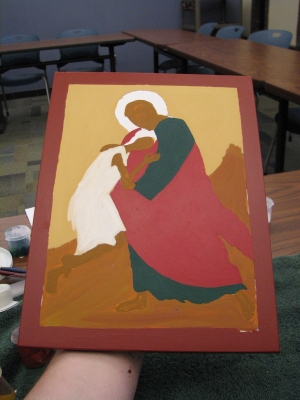
red oxide on the border and the back so the whole panel is "sealed" or stained in red oxide. this apparently is tradition, the icons are not framed but framing techniques are part of the painting.
a turning point
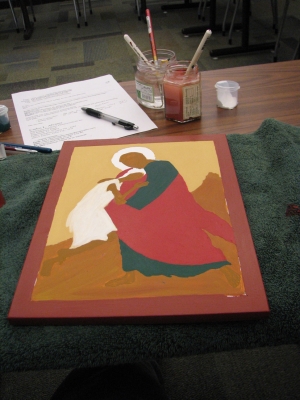
about to add the shading to the robes. here I should have stopped fiddling with the green and the red. I also should have had a lighter touch with later dark layers. This insight is only possible in retrospect.
robe details
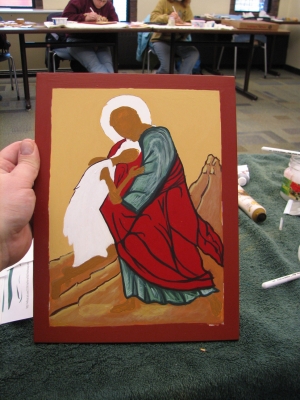
red robe folds added, and some lightening of the green robes. here the paint was probably supposed to be more transparent. I like to think of my paint opacity problems as both a novice's shortcomings and a heterodox Lutheran's better features. If you have to ask, you probably don't care.
hair
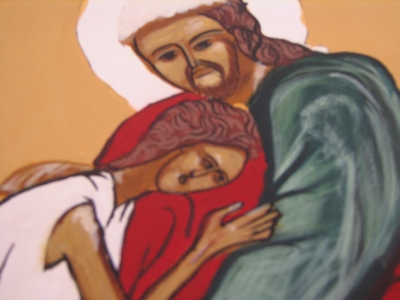
the instructor demonstrated to the class how to do the hair, using my icon. So most of the hair is "hers" however I did the black parts if I recall. It's hard to recall. There's long stretches of this process that aren't perfectly clear in my memory.
hat
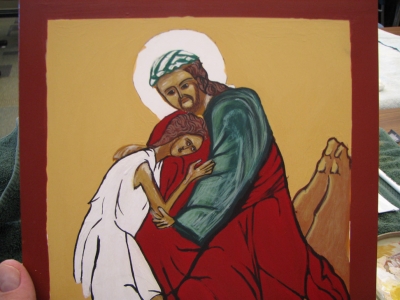
The father's headwrap is something I might have done better than anyone else in the class. That's not bragging, it's just something I got particularly "right".
face details
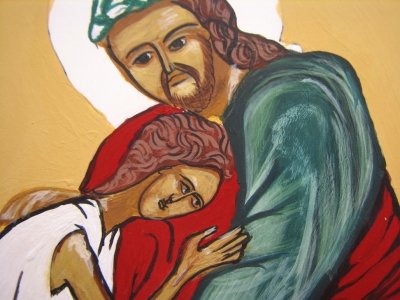
I have grown to really love the father's eyes. the son, not so much. however the faces in this old old icon were small and not nearly as detailed as something like rublev's were. I also am kind of unhappy about the masklike appearance of the facial colors. though the lighting touches and the later assists felt fine to do.
assists
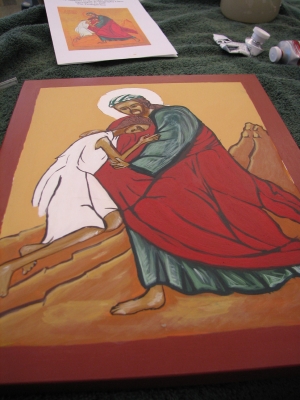
in the large view of this file you can sort of make out the tiny almost-pure-white "assists" which are the final touches of light on some of the bony structures. I didn't do a Great job applying those. But they are meant to evoke the interior light of the person and that as an emanation of the originating light of the divine.
ready for leaf
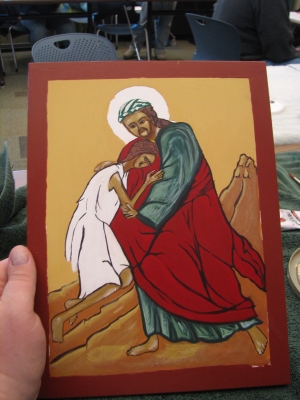
the next step is to put gold leaf on the halo. (see video) At this point, when I see this, I mostly see the imperfections. There is a Lutheran theological point I can make with this, which is to say in short, the "icongraphic process" Worked in my opinion. Though perhaps not in the sense envisioned by the old Byzantine and Orthodox theologies.
several from the class
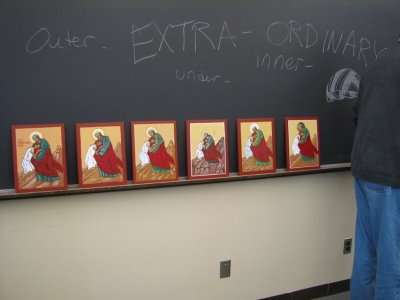
most of them, a couple took theirs before I could snap the pic. note how similar and yet significantly different they all are. the one at far right is probably the best in class. she worked with building and blending the colors a lot. mine is 2nd from the left.
closer views
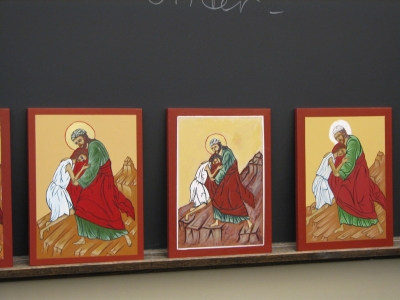
The one at right without the leafing is the instructor's. I don't love her mountain, but her faces and other details and just surehandedness are so lovely
end
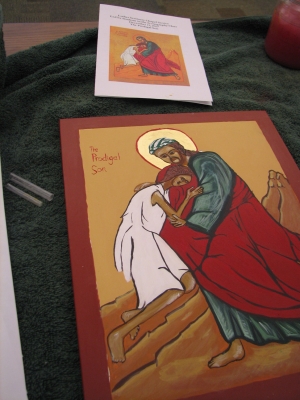
Basically complete, with a bulletin from a chapel service held on campus where the icons were featured.
closer on leafing and text
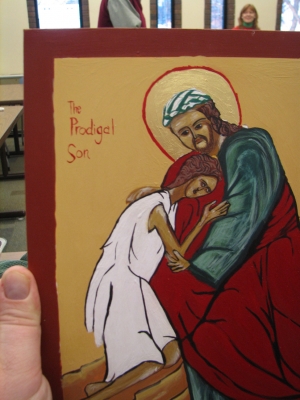
the instructor said we could write the text in english because text on icons was generally written in the language of the painter's vernacular. I thought about doing it in NT Greek, but I have a much surer hand with english letters
the end of class blessing
Download FLV
there is a slowly growing tendency of Lutherans to cross themselves on the speaking of the triune name (F, S, HS) This gesture has never stuck with me. You will note in the video that at the end of the prayer that the woman directly in front of the camera is also "old skool" in that regard--her hands actually kind of go to her pockets! She's the wife of the co-instructor, herself a formidable pastoral caregiver.
15 vote(s)

The Vixen
5
Fonne Tayne
5
EarthMaiden
5
Asian Persuasion
5
Flitworth
5
Spidere
5
JJason Recognition
5
Charlie Fish
5
Blue
5
teucer
5
Malaysian Eddy
5
Darkaardvark
5
Jellybean of Thark
5
rongo rongo
5
Waldo Cheerio
Favorite of:
Terms
(none yet)16 comment(s)
Man Burn Unit, you many words.
JJason: uh, thanks?
Ha! Many words!!
Lately I've been guilty of a similar vice. But, at the risk of reviving and long-dead and never too serious rivalry... many words!
Writing long proofs isn't a vice. It's going the extra mile.
r0ckc4ndy: I would especially like it if your own vice led to something that appeared on the praxis! you have made so many lovely praxes, it would be nice to see that again.
Thank you Burn Unit!
I'm hoping to get back in the game, it's just been hard right now. I have some ideas. I have some plans. But right now the only thing I have is a Failure and I don't even have time to post it properly.
But, in 28 hours I will have a lot more time!
So tough to read an invisible praxis. Genious indeed.
I wish I hadn't voted for this task before so I could vote for it now.
Thanks! I didn't think you read that much anyway, so i was just relishing my existing comments and anticipating further ones.
Perhaps I should restore the original proof.
Thats what you get for thinking.
I Likes and I read a little more day bye day!
sorry about the weirdness with this proof, everybody. Yesterday was a grim day and I was feeling quite touchy. That was just a tantrum. Thanks for the votes folks. All you other party people in the place, what happened?
Well, your tantrum was super-cool looking. Hope things are looking less grim. Or at least, surmountable?
I just wanted to come back and have a look at this again. Delicious.
There's something odd about calling an icon an inanimate object, because they have a kind of depth or soul to them that while not animate is not entirely inanimate. Fascinating.






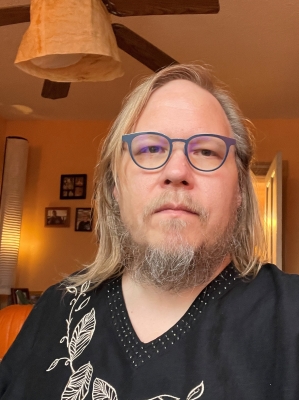

























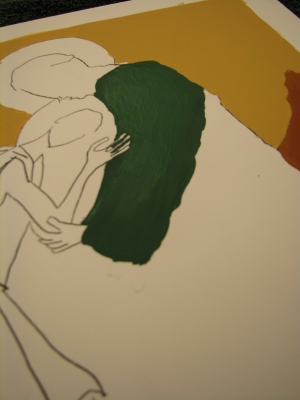
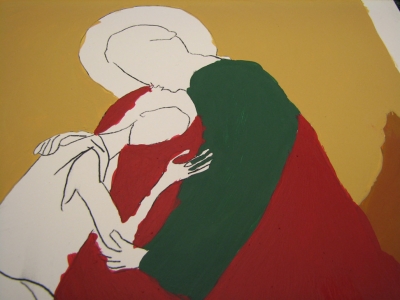
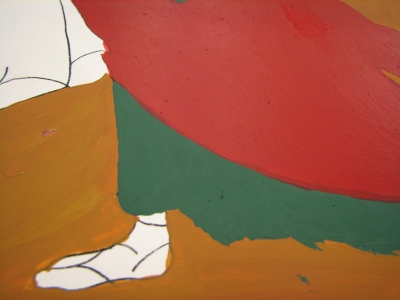
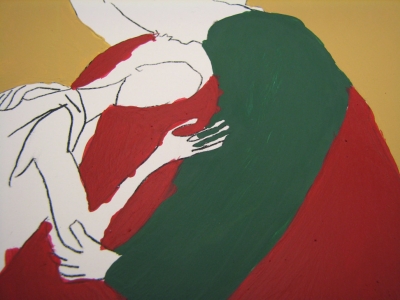
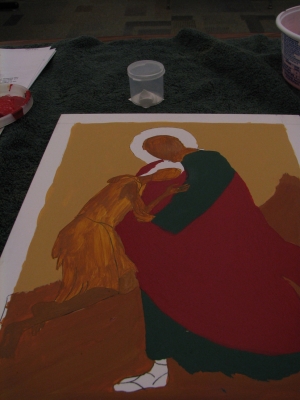
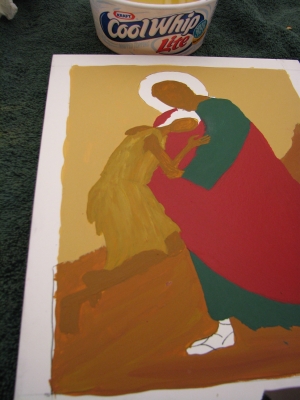
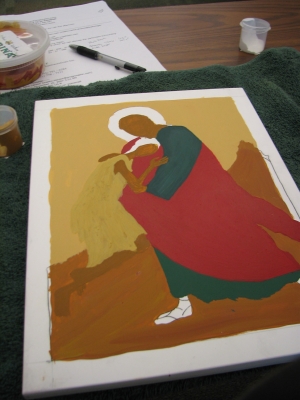
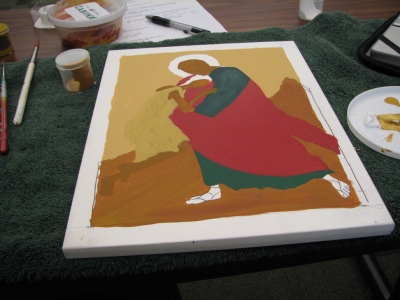
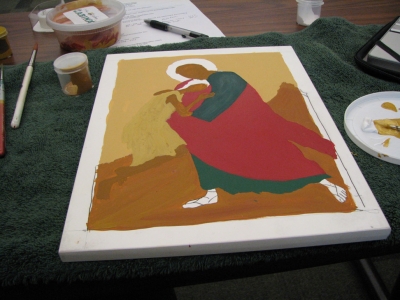
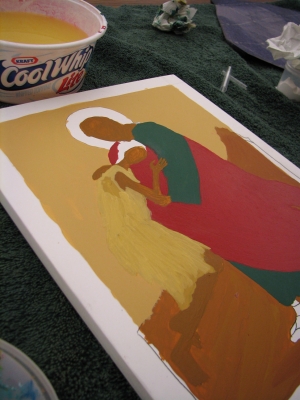
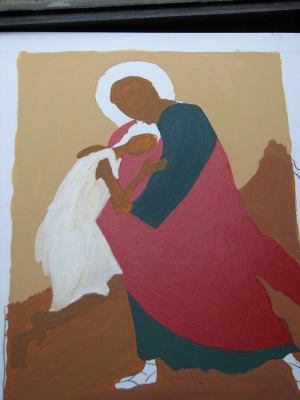
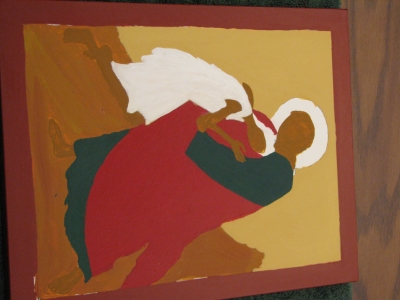
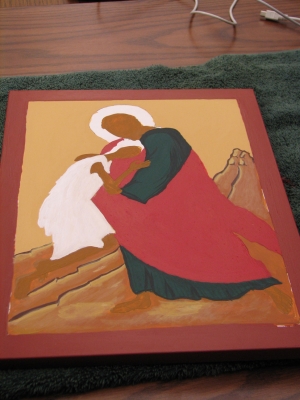
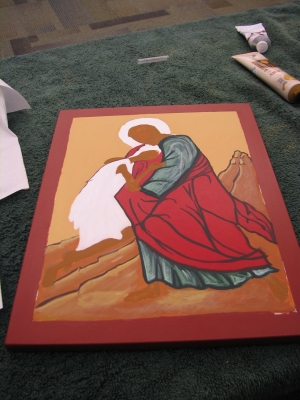
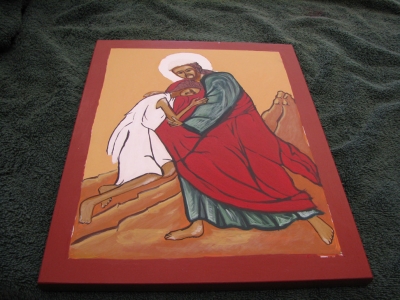
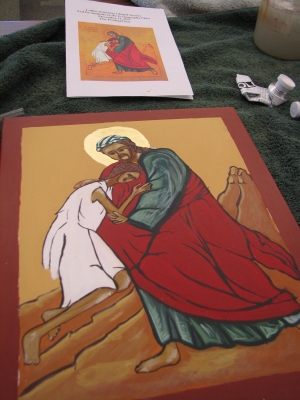
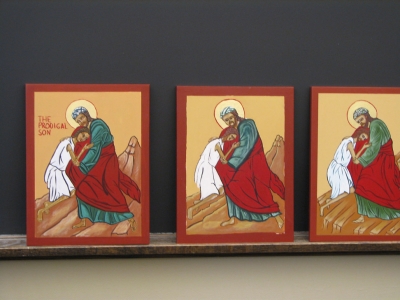








Wow, this is really nice!